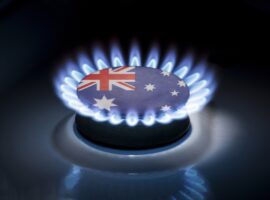The Australian newspaper continues its relentless attack on wind farms, this time complaining that “billions” of dollars worth of renewable energy certificates are being “taken offshore” by foreign wind farm owners.
The article quotes coal advocate Nathan Vass saying that Canberra has allowed “foreign owned companies to buy up Australian wind farms and take billions in renewables subsidies offshore.” The report’s author, environment editor Graham Lloyd, puts the figure at $1.7 billion a year.
It continues a long history of attacks against the wind industry by Lloyd – and once again it appears to be a gross distortion. His claims are even contradicted by his own story.
It’s true that a lot of wind farms in Australia are foreign owned, and that is also the case for the huge number of solar farms that are being built. But apart from the minuscule numbers of wind and solar farms being built and “going merchant”, most of them do not keep the renewable energy certificates, known as LGCs.
Take the wind farm cited by Lloyd in his article, the soon-to-be-built 530MW Stockyard Hill project in Victoria, which was bought this week by Chinese wind turbine manufacturer and project developer Goldwind.
Under the deal signed with Origin, Goldwind will sell the output of Stockyard Hill – and the LGCs – at a combined price of less than $60/MWH (RenewEconomy understands the price to be about $55/MWh), which is less than half the recent wholesale price of electricity in the state.
At that price, Goldwind is effectively giving the LGC’s to Origin Energy for nothing and the subsidy is going to the Australian-owned retailer buying the output.
The exciting thing about this deal is that the developers of wind and solar farms are able to build the projects and accept an increasingly lower amount as payment. It highlights how wind and solar will bring down the cost of generation in Australia, something that is already being reflected in the futures markets.
The companies pocketing the big wins right now are the retailers, like Origin, AGL and EnergyAustralia, who are buying electricity and LGCs at possibly one-third of their current cost. That is the reward of their market power, and they also realise that the price of LGCs will likely fall rapidly once the 2020 RET is met.
Tristan Edis, director at Green Energy Markets said the figure of $1.7 billion in subsidies flowing overseas appears to be built on an assumption that wind farm owners are receiving the full financial value of elevated renewable energy certificate prices and elevated electricity market prices.
“We track every single renewable energy project in the country and can assure anyone this number is completely bogus,” Edis said.
“88% of the electricity production and associated LGCs from wind farms operating and under construction are typically contracted at fixed prices to power retailers like Origin Energy, AGL and state-owned power companies like Synergy, Ergon and Hydro Tasmania.
” These are contracted at prices not all that different to the current forward contract prices for plain old electricity, so you might even argue wind farm owners see no additional benefit from the renewable energy certificate subsidy.
“The companies that are heavily profiting from the current shortage and high spot prices for LGCs and power are energy retailers, not the owners of wind farms.
“If Stockyard Hill was not built then Origin’s next alternative in many cases would be to run the gas-fired Mortlake Power Station. At the current prevailing price of $10 per gigajoule price for gas that would have cost consumers $112.50 per MWh just for the fuel.”
The investors who put their money in such projects, such as Queensland Investment Corp (the Singleton wind farm will receive $65/MWh from AGL) are happy enough to get secure returns, and just don’t want to know about the market risk.
Only those developers with deep pockets are “going merchant”, meaning they get the current price of electricity and LGCs. Goldwind is actually doing that with White Rock wind farm in NSW, because in that case it refused to take what the retailers were offering.
Some developers of solar farms are looking at doing he same, and would like to if they could convince the bankers to manage the market risk. But it is extremely rare and even Goldwind will likely strike a PPA with a retailer at some point.
Lloyd cites two sources for his article, an unnamed “international analysis” and Nathan Vass, from the Australian Power Project, which describes itself as as an “advocacy group” and promotes carbon capture, “clean coal” and supports the Coalition’s preferred new coal-fired power station in north Queensland.
The newly established APP has been making regular appearances in the Murdoch press, critical of renewables and supportive of coal and gas. Vass, a former spokesman for AGL Energy, insists he is independent, and receives no money from the fossil fuel industry, or anyone else for that matter.
“I haven’t received any funding from any group, political party, company or individual. Any expenses I have incurred have come out of my pocket,” he told RenewEconomy by email recently.
Vass said on Thursday by email that he wasn’t the author of the un-named international report cited by Lloyd, and when asked by RenewEconomy to justify the numbers quoted in the story, Vass said we should look at the Clean Energy Regulator data ourselves. Which is why we quoted Edis, because it is his job to crunch those numbers.
Update: Vass later emailed to say the “international report” could be found at http://www.thewindpower.net/. There are a gazillion reports there, and most require a fee of at least $US2,500 to open.
Edis later advised that he had again crunched the numbers from the CER: “Wind farms in 2016 I expect to produce 12.6m LGCs and incorporating wind farms under construction and contracted I come up with 19.2m LGCs in 2019. Multiplying those numbers by $46.52 (the price that Vass said he used) I come up with $586.2m in 2016 and $893.2m in 2019.
We asked Vass again where he got the $1.7 billion number from but didn’t hear back. We’ll update if we do.











